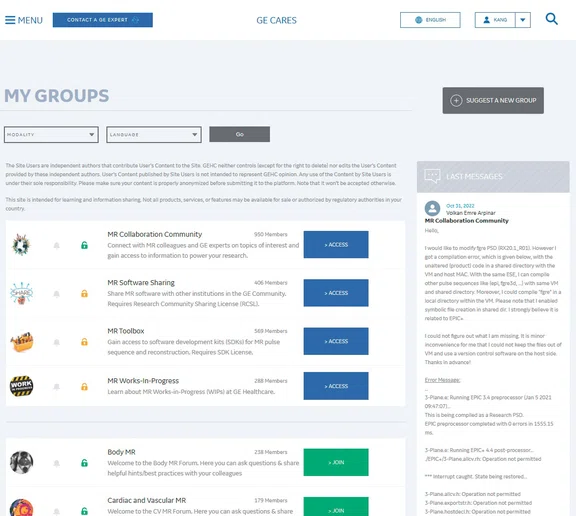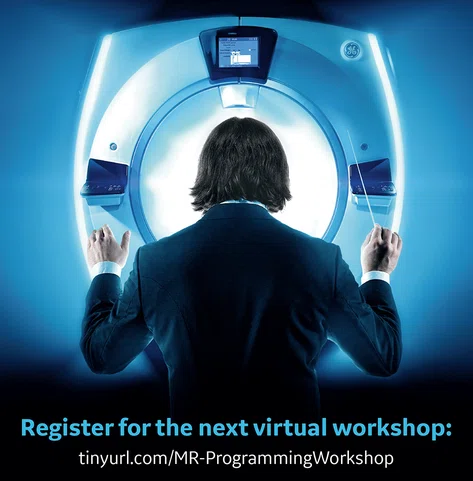Figure 1.
The GE MR Collaboration Community Forum on GECares. com has approximately 1,000 members.


result
PREVIOUS
${prev-page}
NEXT
${next-page}
Subscribe Now
Manage Subscription
FOLLOW US
Contact Us • Cookie Preferences • Privacy Policy • California Privacy PolicyDo Not Sell or Share My Personal Information • Terms & Conditions • Security
© 2024 GE HealthCare. GE is a trademark of General Electric Company. Used under trademark license.
SPOTLIGHT
EPIC and Orchestra software development kits enable advancements in MR imaging
EPIC and Orchestra software development kits enable advancements in MR imaging
As researchers continue to develop breakthrough MR applications, there’s a strong need to have comprehensive access to both pulse sequence and image reconstruction development environments.
As researchers continue to develop breakthrough MR applications, there’s a strong need to have comprehensive access to both pulse sequence and image reconstruction development environments.
Two GE Healthcare Software Development Kits (SDK) can be used to design and implement pulse sequences, as well as to explore innovative image reconstruction concepts and generate clinically presentable images.
GE Healthcare’s Environment for Pulse Programming in C (EPIC) allows scientists to modify and build MR pulse sequences to fit the needs of their research interests, with the ability to make real-time updates and control the system to generate raw data.
The Orchestra SDK gives investigators offline access to GE Healthcare’s image reconstruction environments for MR, making it faster and easier to work on their own reconstruction ideas. With this, they can develop novel reconstruction algorithms faster and with more consistent results. The Orchestra SDK allows users to implement the same image reconstruction routines used on GE MR scanners on any computing platform of their choice. There is also a PET reconstruction toolbox known as Duetto available for development of novel PET reconstructions of list-mode data from the SIGNA™ PET/MR scanner.
“These tools allow our partners to test their own ideas to develop new clinical applications that may ultimately benefit patient care. This can also help them write research grants to get funding for those ideas,” says Kang Wang, Senior Architect – Application Development, GE Healthcare.
Scientists and engineers often want to explore a novel element of a reconstruction they’d like to weave into existing, hardened, robust and well-understood portions of the reconstruction, which can be challenging in traditional algorithm development.
“Orchestra and EPIC provide the tools to help with that process. With Orchestra, they have the flexibility to incorporate their own novel reconstruction technique into a custom pipeline in order to create DICOM images from raw data. They can even customize the acquisition by building their own pulse sequence using EPIC,” says Zachary Slavens, Principal Software Engineer, GE Healthcare.
As Lab Director of the Molecular Imaging/Magnetic Resonance Technology Lab (MIMRTL) at the University of Wisconsin – Madison, Alan McMillan, PhD, and his team are focused on integrating advanced modeling, data science and physics to gain new structural and functional insights into human disease.
“EPIC gives us full control of the MR system’s capabilities, allowing us to make small changes to existing pulse sequences or write entirely new ones as we aim to develop next-generation MR acquisitions and applications,” Dr. McMillan says.
“Orchestra is designed to be available in multiple software languages and on multiple operating systems so that scientists can explore raw data reconstruction from their MR system from anywhere – in their lab, in the coffee shop or on an airplane – wherever they want to do reconstruction coding and experiments. Over the years, we’ve expanded and adapted it in response to what the researchers told us they need,” adds Slavens.
Through convenient MATLAB® and C++ interfaces, along with the more recent addition of Python support for building artificial intelligence (AI) models, developers can now apply their image reconstruction algorithms to the raw data from a scanner and incorporate many previously inaccessible but essential image reconstruction features, such as image un-aliasing with GE’s parallel imaging routines (ASSET and ARC), correction for gradient non-linearities (GradWarp), insertion of DICOM images into the scanner database and more. The Orchestra SDK also includes reconstruction examples from EPI to spectroscopy, with online help to get users started.
A new, more flexible ScanArchive raw data format introduced by GE in 2020 makes it convenient for developers to export all the relevant raw data components needed to test their new reconstruction methods. “This new raw data capability has been very well received by our collaboration community,” says Anja Brau, PhD, GM of MR Clinical Solutions & Research Collaborations at GE Healthcare.
“With Orchestra, we have direct access to GE’s reconstruction techniques, so we can focus more on the application and less reimplementing existing algorithms,” Dr. McMillan adds.
Many experiments are heavily dependent on accessing the Orchestra SDK’s reconstruction tools. Having access to the algorithms in Orchestra allows researchers to examine data offline and refine algorithms consistently with GE’s product reconstruction. This can be helpful in accelerating the translation of research projects into new applications, such as making image acquisition as efficient as possible to improve SNR and reduce scan time, or reducing susceptibility artifacts around MR-Conditional metallic implants.
“We also encourage GE research users to share their SDK-derived software code with other members of our user community through our online MR Software Sharing Forum to facilitate greater impact through multi-site studies,” adds Brau.
GE offers a biannual virtual workshop to help users learn how to use the pulse sequence and reconstruction tools available for researchers on the GE MR platforms. These self-paced, 10-week programs are hosted by GE in conjunction with the University of Wisconsin-Madison. In-person training courses are also offered annually in Europe and Japan. More information about upcoming courses can be found in the MR Collaboration Community Forum on GECares.com.
The workshops introduce users to basic GE EPIC software design, EPIC pulse sequence development tools, how to modify pulse sequences and the steps needed to run a research pulse sequence. They also cover image reconstruction and introduce data structures using Orchestra, as well as how to set up a local EPIC and Orchestra environment.
“It is fantastic that both EPIC and Orchestra allow us to work across a wide range of scanners, operating systems and programming platforms,” says Dr. McMillan. “A healthy collaboration community supports knowledge and prototype sharing across institutions. Collectively with GE, we can advance MR imaging techniques and technologies to help clinicians better assess their patients.”










